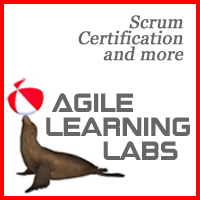A lightweight framework to help people, teams, and complex organizations develop value through adaptive solutions for complex problems. Scrum is the most widely recognized Agile framework and is compatible with other agile practices like Extreme Programming and test-driven development.
Scrum is comprised of a series of short iterations–called sprints–each of which ends with the delivery of an increment of business value. A simple way to remember all the key elements of Scrum is this; “3” roles, “5” events, and “3” artifacts. The 3 roles are: Product Owner, Developers, and Scrum Master. Scrum counts on a Scrum Master to foster an environment where: Product Owners sequence complex problems into a backlog, Developers work on sequenced product backlog items and deliver business value after a sprint, and Developers and Stakeholders take note of their delivery approach during a sprint and look to make improvements for the following sprint. The 5 events that are time-boxed: sprint planning, daily scrum, sprint, sprint review, and sprint retrospective. The 3 artifacts are: product backlog (product goal), sprint backlog (sprint goal), and the product increment (definition of done).
Scrum is deliberately incomplete. Rather than provide people with precise instructions, the rules of Scrum help guide their relationship and interactions. Scrum is not a process, technique, or a definitive method. Scrum is simply a framework and within the framework we may apply various process and or techniques.
Tip: You will sometimes hear the term scrum used interchangeably with the term agile, but this is incorrect. Agile is not a framework, but a broader set of values and practices, while scrum is a specific framework that fits comfortably under the agile umbrella.
Background Of The Term
The term “scrum,” as it is commonly applied to software development, began its life as a sports metaphor. The term “scrum” derives from the game of rugby, where it refers to a team that moves down the field as one body. Scrum was first introduced as a metaphor for industrial processes in 1986 by Hirotaka Takeuchi and Ikujiro Nonaka, two Japanese academics who used it to describe a new, flexible approach in a paper titled “The New New Product Development Game.”
In the early 90’s, several complimentary events conspired to bring the term “scrum” into use within agile development community. In 1990 Peter DeGrace and Leslie Hulet Stahl published a book called “Wicked Problems, Righteous Solutions: A Catalog of Modern Engineering Paradigms,” which contained a blistering critique of the commonly accepted “waterfall” method for software development. DeGrace and Hulet Stahl quoted Takeuchi and Nonaka’s paper as a possible remedy. Influenced by this popular work, a team of software developers, Jeff Sutherland, John Scumniotales, and Jeff McKenna, used the term scrum to describe a new framework they had begun to develop in accordance with the values and principles of the Agile Manifesto. In parallel, Ken Schwaber was developing a similar framework at his company, Advanced Development Methods.
The two teams were aware of each other’s work, and in 1995, Schwaber and Sutherland jointly authored a paper that laid out the basics of a framework they dubbed scrum. Schwaber later collaborated with Mike Beedle on the book Agile Software Development with Scrum. Schwaber went on to found the Scrum Alliance, which is now the certifying body for scrum trainers and practitioners of all levels, and the primary source of authoritative information on the state of scrum as practiced today.
Further Learning
The Scrum Guide – by Ken Schwaber & Jeff Sutherland

